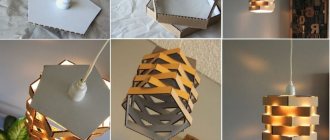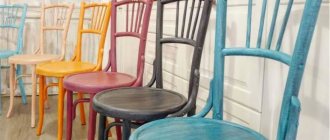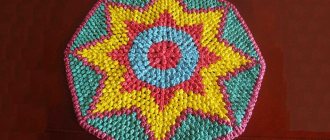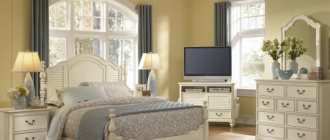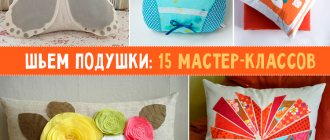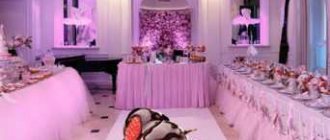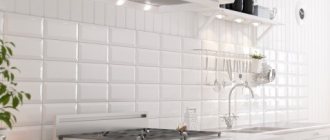The market for decorative materials for surface finishing is very diverse. One of the original options for decorating a room is painted walls. Such cladding looks unique, even if an ordinary replica of a famous painting is used. She is able to create a unique atmosphere in the room. Therefore, it is worth figuring out how to paint the walls with your own hands, what is required for this and what are the features of each method.
Idea 1. Painting walls using a stencil (+ master class)
Stencils come in handy when you need to outline the contours of a complex image, draw letters, numbers or any repeating patterns.
To paint the walls, you can use a ready-made template or one made to order in a printing house. Such stencils can be flexible or rigid, one- or two-layer (to create a multi-color pattern), self-adhesive or glueless. They are generally durable, fit tightly to the wall, and are designed to be reusable.
- Do you want to purchase a super-fashionable and unusual stencil? We advise you to search for it in the international online store Etsy using the query “stencil” (price from 10 to 100 $).
However, you can make a simple single-layer stencil for painting walls with your own hands, following our step-by-step instructions.
What you will need to make a stencil: office paper, plastic film or thick paper (for example, whatman paper or wallpaper), pencil, scissors, a stationery knife or a special knife for cutting stencils, masking and transparent tape, as well as a printer and some kind of graphic editor (vector or raster).
What you will need for stencil painting of walls: paints (preferably water-based acrylic), a synthetic round brush (7 cm in diameter for painting large designs and smaller ones for finer work), a sponge (can be used instead of brushes) and paper napkins for removing excess paints.
Instructions:
Step 1. Find a suitable vector(!) stencil on the Internet, for example, on the website https://www.getpattern.ru/. Please note that it is advisable to choose a contour image (or make it as such, following these instructions), because colored areas will only waste ink when printed.
- It is also important that the stencil does not have bridges that are too thin, otherwise the paint underneath may leak and ruin the design. Or they may simply break.
Step 2. The selected picture must be scaled to the desired size and printed. This is very easy to do if the stencil size does not exceed A4 format. However, if you need to print a large template, then you need to break it into several parts, following these instructions. Next, all you have to do is assemble the picture as a mosaic.
- If you are using transparent vinyl film, then you just need to lay it over the original design, trace its contours with a felt-tip pen or pen, then cut out the unnecessary segments (see photo).
12
Step 3. At this stage, the A4 paper stencil must be covered with transparent tape on both sides and overlapped (!) to protect the paper from getting wet. Finally, use a craft knife to cut out all the segments intended for painting.
If you have printed several A4 sheets for a large stencil, then at this stage you can immediately start cutting, but keep in mind that you will have to paint the stencil with an almost dry brush so that the paper does not get wet. But in order not to take risks, it is advisable to laminate the design or copy it onto a denser base (for example, vinyl wallpaper). To do this you can:
- Use carbon paper (place it between the base and the printouts, and then trace all the lines with a pencil).
- Cut out all the holes for painting from the printed drawing, and then transfer its contours to the base. Next, you need to take the knife again and cut out segments for painting, now on the base.
When cutting out the stencil, be sure to protect the table from scratches by placing some kind of backing on it, such as glass.
Step 4. Now it's time to glue the stencil to the wall. To do this, try on your template to the selected location, align it with the building level and glue it with tape. If necessary, for example, if you need to draw repeating elements at equal intervals, you must first make markings using a building level.
- If the stencil has thin and movable bridges, secure them with small pieces of double-sided masking tape (you can twist a piece of regular masking tape into a ring).
- A more convenient way to fix the stencil is with a low-adhesion spray adhesive, which allows you to remove the template easily and without a trace (sold in craft stores).
Step 5. Hurray, the most labor-intensive work is left behind, it's time to start painting.
- If you are using a sponge: dip the sponge into the paint, wipe off the excess on a napkin, then begin painting the stencil using a tamping motion.
- If you are using brushes: dip the brush into the paint, then roll it around a little on a cloth to remove the excess (the bristles should be almost dry), then start painting in a circular motion. Be careful when painting areas near the very edges of the stencil so that paint does not bleed under the holes and ruin the outline of the design.
- If you are using spray paint: spray the paint carefully, in thin layers and in several passes to avoid smudges.
- If you are using a roller: place the roller in the paint trough, wipe it on a napkin, then start painting. Along the edges of the stencil, move the roller from side to side, not up and down.
Step 6. When the drawing on the wall is completely dry, coat it with matte varnish to protect it from moisture.
See also: Decor and design of the dining area
Drawing techniques
There are many techniques for applying images. The choice of technique, as well as style, largely depends on your artistic abilities.
If you want to see something complex and multifaceted in your interior, but you cannot depict it yourself, then feel free to contact professionals.
Idea 2. Painting checkered walls (+ master class)
As you know, check is the most versatile print that never goes out of style. It fits perfectly into both classic and modern interiors, both into the interior of the kitchen and children's bedroom. You can decorate one or more walls with a cage using wallpaper or painting.
- Painting checkered walls with your own hands is somewhat more difficult than gluing checkered wallpaper, but painting gives a better result: the painted surface can be washed, repainted, and most importantly, it does not have seams that risk peeling off.
The easiest way is to paint walls in a large Vichy checkered pattern, as in this collection of photos.
Painting walls in Scottish tartan requires a little more effort, but still, it is accessible even to beginners - after all, the accuracy of the markings, rather than painting skills, is what is important here.
And now we suggest you familiarize yourself with the step-by-step instructions for painting walls with your own hands in tartan, as in the photo below.
What you will need: 4 paints of the same color, but in different tones (in this project we used light olive for the background, a slightly more saturated marsh shade for vertical and horizontal stripes, an even darker one for the intersections of stripes, as well as two paints of contrasting colors), brushes , roller, masking tape and laser level, stepladder and other basic painting supplies.
- It is best to use blue masking tape for painting walls, which can be removed without leaving a trace, without damaging the wall covering, and is marked “for clean lines.”
Instructions:
Step 1: Prepare the wall for painting, then paint it with the background color using a roller. In this master class, the background is a light olive tone of paint. Allow the background layer to dry before moving on to the next step.
Step 2. Mark vertical stripes of equal width on the wall using a laser level and masking tape. Then paint them with a paint darker than the background and let dry.
To ensure that the lines are smooth and clear, and the paint does not flow under the masking tape, use a small brush to paint along the tape and a larger brush to paint the main body of the strip. It is important to ensure that there is no excess paint on the brush. The movement of the brush should not be up and down along the tape, but left and right (across the tape).
Step 3. Now mark the horizontal stripes in the same way, paint over them and leave to dry.
Step 4. Paint the intersections of the stripes in an even more saturated shade to create the effect of layering threads of the same color in the checkered fabric (as if that made the cells darker than the stripes).
- By the way, if you want to paint the walls in a Vichy checkered pattern, then at this stage the work can be considered completed.
Step 5. It's time to draw the contrasting thin stripes that are required for the tartan check.
To do this, again use the laser level and masking tape, mark a line along and in the center of the vertical stripes. Next, paint over them and let dry. Then use the same paint to draw lines along the horizontal thick stripes.
Step 6. Finally, we draw cells of a different contrasting color (in this master class it is blue). The technology is still the same, but the cell becomes larger, since the stripes are drawn along the lines of the first background layer.
Step 7. All that remains is to coat the painted wall(s) with matte varnish to enhance its moisture resistance and strength.
See also: Decorating walls with plates - master class and 100 photos for inspiration
Let's get down to business
Having decided on the choice of design, colors and technique, we move on to creating the image. We offer several options for different rooms.
| Room | Material | Example |
| living room | watercolor | purple orchids on a blank wall |
| bedroom | oil paint, pastel pencils | stenciled love tree |
| children's | tempera paint using fluorescent | cartoon characters or animals |
| kitchen | oil | fruit still life in warm colors |
| bathroom | any paint with a mandatory varnish coating | marine motifs |
Shall we decorate the rooms?
The landscapes in the apartment will look very beautiful
Living room
The choice of color scheme and theme depends on the overall style of the room. Black silhouettes of any kind you like are well suited for any color. They will fit harmoniously into cold and warm shades, without looking gloomy.
For a large living room, a watercolor painting on the entire wall would be an excellent option. Make it in cool, light colors to create a feeling of freedom and space, or use warm colors to create coziness.
An example would be a floral painting in purple or blue shades with the addition of green on a white background. In this room it is better to use hand painting.
For large rooms, you can make a large painting on the entire wall.
Bedroom
The help of stencils will be appropriate here. You can use them to create original patterns, making a photo frame that will be an excellent addition and a reminder to the couple of the wonderful moments spent together.
For the bedroom, it is recommended to use calm motifs and warm colors. From the cold range, gray, blue and light green are suitable. Add white notes, and a gentle, relaxing design is ready.
It is better to use calm tones in the bedroom
Children's
In this room, creative thoughts are allowed to be fully realized. You can create an original and fashionable design by inviting a master. Then you will get an abundance of bright colors and an accurate representation of the chosen theme. Having artistic talent, you will be able to independently depict your child’s favorite characters by decorating the entire wall.
If your talents do not allow you to create on a large scale, you have a chance to paint a wall with your child. To do this, use stencils or projector equipment. This choice will be a good opportunity to have fun together and let your child show his artistic abilities.
The children's room should have bright colors
Idea 5. Painting with chalk on a slate wall
By decorating one or two walls with chalk wallpaper or slate paint, you will have the opportunity to change the pictures on the wall every day, write down foreign words, to-do and grocery lists, instructions for household members, motivating or just funny phrases. A chalk wall looks especially cool in the interior of a children's room and kitchen.
- If you want to keep your chalk painting forever, you just need to coat it with matte varnish.
- You can (and should!) draw on a slate surface not only with crayons, but also with chalk pencils, markers and paints.
- Lettering (the so-called painted words) looks especially impressive on a dark wall. True, if you are not a professional font designer or an artist, then it is unlikely that you will be able to write words beautifully, but you can do this with the help of a homemade stencil. The main thing is to find a suitable blank on the Internet.
Rules of care
Despite the fact that the materials and the method of their application differ from those used in the Middle Ages, some care for the product will be required.
- First, don't forget to varnish the picture. This will simplify care and allow it to remain fresh for a long time.
- If coating is not part of the plan, use a dry cloth to remove dust.
- Monitor the temperature and humidity of the room.
- If the drawing has smudged, make small corrections with a brush.
- Periodically update the brightness of the image, or change it completely.
In general, when using a protective coating, maintenance is reduced to removing dust from the wall with a damp cloth. The rules of care are quite simple, so you can safely make your dreams come true, creating unrealistic images to your delight and to the envy of your friends.
Idea 6. Striped wall
Striped walls not only look cool, but also visually correct the shortcomings of the room. For example, vertical stripes “raise” low ceilings, while horizontal stripes increase space and push walls apart.
It’s very easy to paint walls with stripes with your own hands; the main thing here is to carefully stick the masking tape and correctly calculate the optimal width and number of stripes.
- To find out the required number of stripes of the same width, but alternating in color, you need to divide the height or width of the wall by the desired width of the stripes. But there is one nuance - if the number of stripes is even, then along the edges of the wall the stripes will be of different colors. To make the number of stripes odd and the wall design symmetrical, you can “play” a little with the width of the stripes or simply divide the height or width of the wall by an odd number. For example, a wall 270 cm high can be decorated with 17 stripes 16 cm wide.
In order for the stripes under the ceiling and above the floor to be the same color, there must be an odd number of them
- It is desirable that the stripes have a width of 10-30 cm. A width of less than 10 cm will be too narrow, and more than 30 cm will be too wide and heavy.
- The best way to paint stripes is to use blue masking tape that can be removed without leaving a trace, without damaging the wall covering, and labeled “for crisp lines.”
- To ensure that the lines are smooth and clear, and the paint does not flow under the masking tape, use a small brush to paint along the tape and a larger brush to paint the main body of the strip. It is important to ensure that there is no excess paint on the brush. The movement of the brush should not be up and down along the tape, but left and right (across the tape).
Ideas for lovers
It’s great if you have some drawing skills, then you can draw with your own hands not only cute characters and animals, but also a whole plot, for example, as in this photo selection of interiors with painted walls.
It is especially worth highlighting the theme of trees, which is fertile for creativity - they are not difficult to draw, but you can come up with so many interesting details! For example, these could be birds or fairies sitting on branches, beautiful leaves or flowers, squirrels or butterflies.
Mirrors - functional room decor
Not a single house is complete without a mirror, and if a representative of the fair sex lives in it, then there may be quite a few such interior items.
Therefore, women are very attracted to the idea of decorating the walls with mirrors. They can be placed in several lines horizontally or vertically, hung in a chaotic manner, or used to decorate the entire surface of the wall. Start taking action and inspiration will come. It is not necessary for mirrors to have a strict geometric shape. The use of mirrors of different sizes and shapes is encouraged. They can also be placed in decorative frames. For a girl's room, the most suitable option is a collection of elegant mirrors on ropes or chains.
using two mirrors to decorate the living room walls
Decorate corners? No problem!
Corners should not be empty and faceless. But those who have at least once tried to decorate wall surfaces on their own come to the conclusion that corners are the most difficult place to decorate. There is no need to worry, many professionals fully agree with this point of view. But this is a winning place for any decor, and correctly selected details will turn an unremarkable corner into an original part of the interior. Designers offer the most original ways to decorate corners:
- corner photographs;
- decorative baguettes;
- tile;
- stone;
- shelves.
stylish floor lamp as decor for a corner area
Such elements can be arranged into an effective composition or used separately. A small gallery of paintings or photographs will enliven an empty corner. But don't overdo it. It's better to leave the corners a little empty than overloaded.
Conclusion
Now you know how to decorate the walls of your home with your own hands. Many people think that bringing various design ideas to life requires the help of professionals and a lot of money, but, fortunately, this is not at all the case. A person who has basic skills in handling the simplest building materials and tools can create a unique decoration with his own hands.


